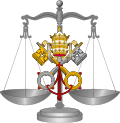A doctor of both laws, from the Latin doctor utriusque juris, juris utriusque doctor, or doctor juris utriusque ("doctor of both laws") (abbreviations include: JUD, IUD, DUJ, JUDr., DUI, DJU, Dr.iur.utr., Dr.jur.utr., DIU, UJD and UID), is a scholar who has acquired a doctorate in both civil and church law. The degree was common among Roman Catholic and German scholars [1] of the Middle Ages and early modern times.
Contents
Today, the degree is awarded by the Pontifical Lateran University after a period of six years of study, the University of Würzburg, the University of Fribourg, and the University of Cologne. [2] The Catholic University of America does not award the doctor utriusque juris as a single degree, but instead offers a dual doctorate in canon and civil law. [3]
Between approximately the twelfth through the eighteenth centuries, European students of law mastered the Ius commune, a pan-European legal system that held sway during that span. It was composed of canon (church) law and Roman and feudal (civil) law, resulting in the degree of "Doctor of both laws". [4] or of "Licentiatus of both laws".
